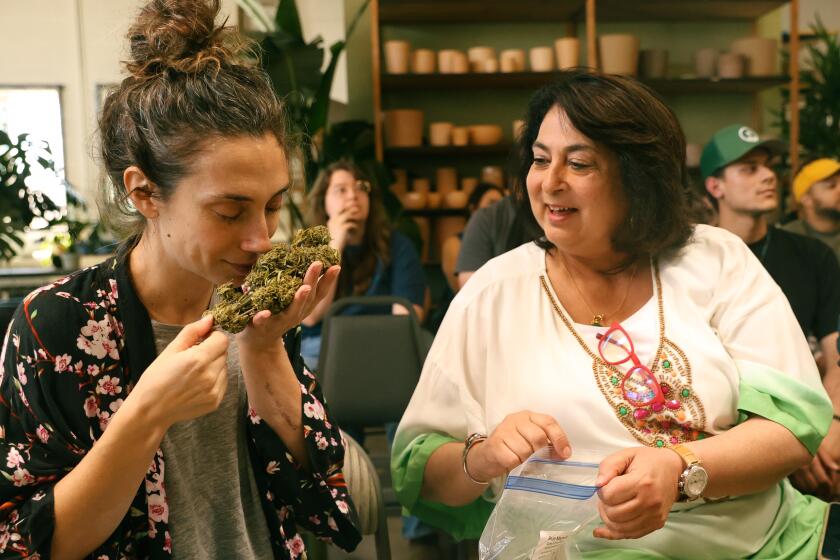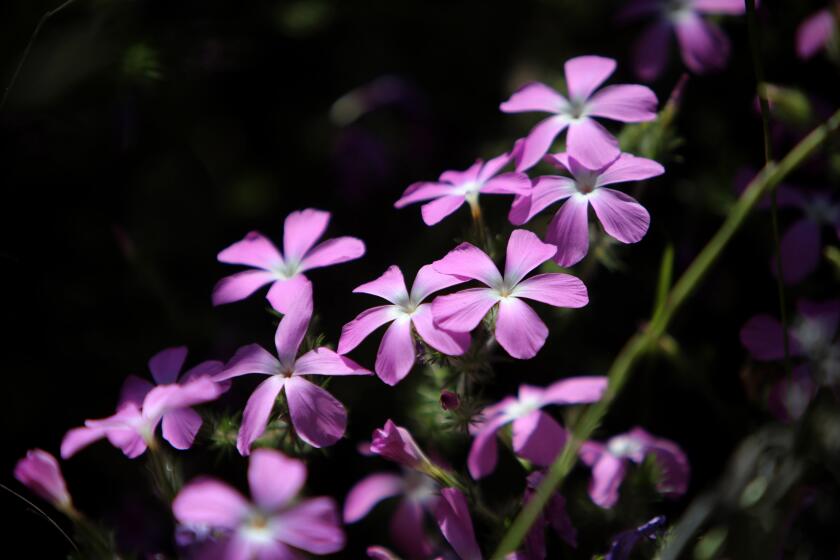Culinary Herbs Need Some Extra Attention
Question: I would like to plant some herbs for cooking. Which ones would you recommend, and what conditions do they require?
S.C., Newport Beach
Answer: Culinary herbs enhance the flavor of foods. Which ones you choose to grow depends on the type of foods you prefer to eat. For instance, if you are a pesto lover, then you will want to grow basil.
Serious cooks will probably want to include the following in their herb garden:
* Basil: Plant in early summer in rich, well-composted soil in full sun. Once plants are 6 inches tall, pinch the growing tips back to the next leaf node to encourage bushiness. Also pinch off flowers to delay seed formation. Water, fertilize and harvest regularly.
* Chives: This plant prefers at least six hours of sun per day and rich, well drained, moist soil. Plant seedlings in spring (planting from seed takes a year, before the foliage is large enough to harvest). Fertilize young plants three or four times during their first summer. To harvest, cut leaves or flowers 1 inch above the crown (the flowers are edible too). Renew chives by dividing them every three to four years.
* Cilantro: Plant this herb in the cooler months for healthy foliage and to prevent it from bolting to seed. The fresh leaves are called cilantro (an essential in salsa) and the seeds are known as coriander. The plant grows quickly from leaf to seed. Grow in rich, well-drained soil in full sun. Provide adequate water and fertilizer such as fish emulsion and seaweed solution to young and recently harvested plants. Don’t overfertilize, which will lead to lush foliage, but decreased flavor. Aid seeds in germinating by soaking them overnight, or scratching their surface. Use slow bolt varieties, or plant every few weeks to extend your harvest.
* Dill: This herb prefers a sunny, well-drained site, with afternoon shade in hot, inland areas. Grow from seed or transplant, being careful with their delicate taproots when planting. Dill grows best when daytime temperatures are between 70 and 95 degrees. Any hotter and they will quickly flower, set seed and die. (Harvest the seeds to be used in breads, crackers.)
For continuous harvest, sow seeds every two to three weeks. Keep soil moist until the seedlings are 5 inches tall, then water as needed. Feed plants lightly with diluted fish emulsion or other liquid fertilizer, every four weeks. Mature leaves can be snipped eight weeks after planting from seed.
* Sweet marjoram: Grow this perennial herb in full sun in fairly moist soil by transplant or seed. Remove blooms and trim to prevent woody growth. To harvest, take tender tips in the early morning when the sun has just dried the dew on the leaves.
* Mint: The No. 1 thing to remember about this herb is to grow it in a confined area, such as a pot or a bed by paving. It spreads vigorously underground and can take over an area. When growing in pots, select a container that is at least eight to 10 inches in diameter, so it has room to spread. Mint prefers rich soil, plenty of water and part shade, although in sun they develop the best flavors. Trim to stimulate new growth and cut off flowers when they form. Some choice varieties include spearmint (Mentha spicata), ‘Kentucky Colonel,’ chocolate peppermint (M. x piperita var. officinalis and var. piperita), pineapple mint (M. suaveolens, which is great in tea blends, and apple mint (Mentha x villosa variety Alopecuroides).
* Parsley: Flat-leafed Italian parsley is the No. 1 choice for culinary use. It can be started from seed or transplants. Soak seeds 24 to 36 hours in hot water. When seedlings are 5 to 6 weeks old, transplant. Harvest once stalks are 6 inches long. Replace each year, as parsley will go to seed the second year. It likes full sun or a few hours of afternoon sun, average soil and regular watering. Harvest by picking outside stalks at the base, never taking off more than one-third of the plant, and always leaving new growth at the center.
* Rosemary: Rosemary prefers full sun and requires little water, once established. Needs good drainage. Pinch tips when plants are small to control growth. Numerous upright and trailing varieties to choose from. Can grow into large bush.
* Sage: Prefers full sun but will tolerate some light shade. Plant in ordinary garden soil with good drainage. Start via seeds or transplants. After they bloom, cut off a few stems at the base to stimulate new growth. Never harvest greater than one-third of the foliage at the same time.
* Summer savory: This annual should be grown in rich, well-drained soil in full sun and provided with moderate water. Does well in containers. If you choose to start summer savory with seed, don’t cover the seeds, as they need light to germinate. Use liquid fertilizer such as fish emulsion after each harvest if it is slow to re-sprout. Harvest as needed throughout summer and fall, or take a couple of inches off the top every three weeks.
* Thyme: Thrives in full sun and dry conditions with average soil that has good drainage. A few of the variegated cultivars will tolerate part shade. Prune thyme right after the plant has finished blooming. Cut off the dead flower heads and shape up the plant. When you prune, don’t cut back into the older, woody parts of the plant.
Have a problem in your yard? University of California Cooperative Extension (UCCE) Master Gardeners are here to help. These trained and certified horticultural volunteers are dedicated to extending research-based, scientifically accurate information to the public about home horticulture and pest management. They are involved with a variety of outreach programs, including the UCCE Master Garden hotline, which provides answers to specific questions. You can reach the hotline at (714) 708-1646 or send e-mail to ucmastergardeners@yahoo.com. Calls and e-mail are picked up daily and are generally returned within two to three days.



